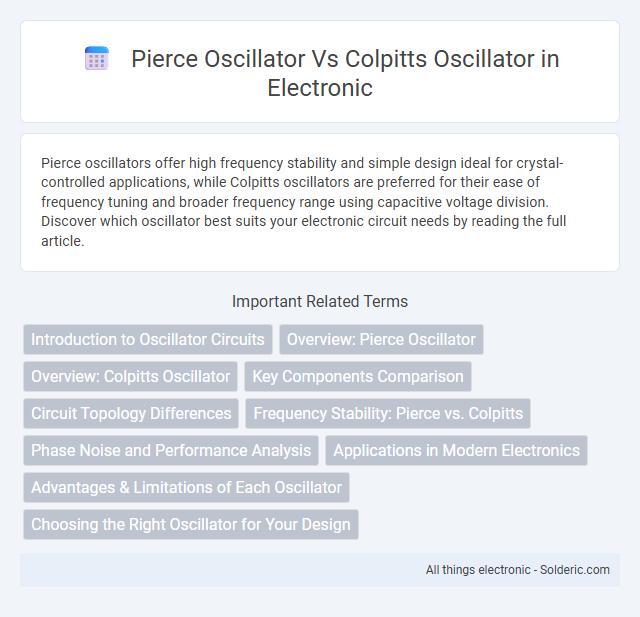Pierce oscillators offer high frequency stability and simple design ideal for crystal-controlled applications, while Colpitts oscillators are preferred for their ease of frequency tuning and broader frequency range using capacitive voltage division. Discover which oscillator best suits your electronic circuit needs by reading the full article.
Comparison Table
| Feature | Pierce Oscillator | Colpitts Oscillator |
|---|---|---|
| Oscillation Type | Crystal-controlled oscillator | LC tank oscillator |
| Frequency Stability | High (due to crystal) | Moderate (depends on LC components) |
| Frequency Range | Typically 1 MHz to 50 MHz | Wide, from few kHz to GHz |
| Feedback Network | Uses a crystal and capacitors | Uses capacitive voltage divider |
| Application | Clock generation, precise timing | RF signal generation, tuning circuits |
| Complexity | Simple, fewer components | More complex, requires careful tuning |
| Power Consumption | Low to moderate | Varies, generally higher than Pierce |
Introduction to Oscillator Circuits
Pierce oscillator and Colpitts oscillator are common crystal oscillator circuits widely used in frequency generation applications. The Pierce oscillator utilizes a quartz crystal with a feedback capacitor network to stabilize oscillation frequency, offering high frequency stability and low phase noise. Your choice between these circuits depends on the desired frequency accuracy, load capacitance, and application requirements such as clock generation or RF signal synthesis.
Overview: Pierce Oscillator
Pierce Oscillators utilize a crystal resonator and a single transistor to generate stable and low-phase-noise oscillations, making them ideal for high-precision frequency applications. Their simplicity and reliability are favored in clock generation circuits within microcontrollers and communication systems. You can achieve excellent frequency stability with minimal component count compared to Colpitts oscillators, which rely on LC tanks and offer wider tuning ranges but less frequency precision.
Overview: Colpitts Oscillator
The Colpitts oscillator is a popular LC oscillator circuit known for its stable frequency generation using a capacitive voltage divider as the feedback network. It typically consists of a transistor or operational amplifier with an inductor and two capacitors that set the oscillation frequency through their combined reactance. This oscillator is widely used in RF applications due to its low phase noise and ease of frequency tuning compared to other oscillator types like the Pierce oscillator.
Key Components Comparison
The Pierce oscillator primarily utilizes a quartz crystal, a single transistor or inverter, and two capacitors forming a capacitive voltage divider, providing high frequency stability and low phase noise. The Colpitts oscillator relies on an LC tank circuit composed of an inductor and a split capacitor network, alongside a transistor or vacuum tube, enabling easy frequency tuning but with comparatively less stability. Both oscillators use feedback mechanisms, but the Pierce oscillator's crystal ensures precise frequency control, whereas the Colpitts oscillator's frequency depends largely on the inductance-to-capacitance ratio in the tank circuit.
Circuit Topology Differences
The Pierce oscillator employs a single transistor or inverter with a quartz crystal connected between the input and output, relying on a capacitive divider to provide feedback, which simplifies the circuit topology. In contrast, the Colpitts oscillator uses a transistor with a tank circuit formed by a quartz crystal and two capacitors in series, where the capacitive voltage divider delivers the necessary feedback for sustained oscillations. This fundamental difference in feedback network design affects the stability and frequency accuracy, with the Pierce oscillator often preferred for its simpler and more compact configuration.
Frequency Stability: Pierce vs. Colpitts
Pierce oscillators are known for superior frequency stability due to their crystal-controlled design, minimizing variations caused by temperature and supply voltage changes. Colpitts oscillators rely on LC tank circuits, which are more susceptible to frequency drift under environmental fluctuations. Your choice between the two should consider the required frequency precision, with Pierce oscillators favored for high-stability applications.
Phase Noise and Performance Analysis
Pierce oscillators typically exhibit lower phase noise compared to Colpitts oscillators due to their simpler feedback network and lower power consumption, making them advantageous in low-noise applications such as crystal-based frequency references. Performance analysis reveals that Colpitts oscillators offer better frequency stability and higher output amplitude owing to their capacitive voltage divider feedback, which enhances signal gain and tuning range. However, the Pierce oscillator's minimal component count reduces parasitic effects, improving long-term phase noise performance in precision timing circuits.
Applications in Modern Electronics
Pierce oscillators are widely used in crystal-controlled frequency generation for clock circuits, offering high stability essential in microprocessors and communication devices. Colpitts oscillators excel in RF signal generation and amplification due to their efficient frequency tuning and low phase noise, making them ideal for wireless transmitters and receivers. Understanding the specific requirements of your application helps determine whether the Pierce oscillator's crystal accuracy or the Colpitts oscillator's tunable frequency range is more suitable.
Advantages & Limitations of Each Oscillator
Pierce oscillators offer simplicity and a low component count, making them ideal for crystal-stabilized frequency generation with high stability and low phase noise, but they are limited in frequency range and output signal amplitude. Colpitts oscillators provide a broader frequency range and better frequency tunability through capacitive voltage division, yet they tend to have more complex design requirements and can exhibit higher phase noise compared to Pierce designs. The choice between Pierce and Colpitts oscillators depends on the application's need for frequency stability, tuning capability, and circuit complexity.
Choosing the Right Oscillator for Your Design
Pierce oscillators offer simplicity and low power consumption, making them ideal for crystal-controlled frequency stability in your design. Colpitts oscillators provide a wider frequency range and better amplitude stability, suitable for applications requiring high-frequency signal generation. Evaluating the frequency accuracy, power requirements, and circuit complexity will help you choose the right oscillator for your project.
pierce oscillator vs colpitts oscillator Infographic

 solderic.com
solderic.com